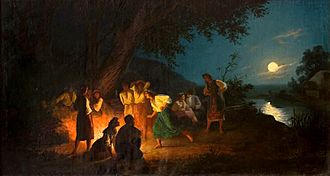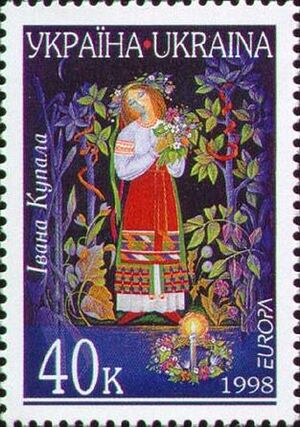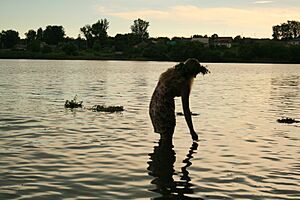Kupala Night facts for kids
Quick facts for kids Kupala Night |
|
|---|---|

Night on the Eve of Ivan Kupala, by Henryk Hector Siemiradzki
|
|
| Also called | Feast of St. John the Baptist; Иван-Купала; Купалле; Іван Купала; Noc Kupały |
| Observed by | Slavic people |
| Significance | celebration relates to the summer solstice |
| Date |
|
| Related to | Summer Solstice, Nativity of St. John the Baptist |
Kupala Night, also called Ivan Kupala, is a special holiday celebrated by Slavic people. It's a very old tradition that happens around the summer solstice. This is the time of year when the days are longest and the nights are shortest.
In countries like the Czech Republic, Poland, and Slovakia, it's celebrated on June 23 or 24. In Eastern Slavic countries like Belarus, Russia, and Ukraine, it falls on the night of July 6 to 7. This is because they use an older calendar called the Julian calendar.
Kupala Night is full of fun Slavic rituals. People collect special herbs, light big bonfires, and even bathe in rivers.
Contents
History of Kupala Night
The holiday was originally called Kupala. It was a pagan celebration linked to nature and new life. Later, when Christianity spread, the holiday was connected to St. John's Day. St. John's Day is celebrated on June 24.
Because Eastern Christianity uses the old Julian calendar, June 24 on that calendar actually falls on July 7 in the more modern Gregorian calendar. This is why the dates are different. The name "Kupala" was then combined with "Ivan" (which is like John) to become "Ivan Kupala."
The word Kupala might come from an old Slavic word for bathing. This made it easy to connect with St. John, who baptized people by putting them fully in water. But the traditions of Kupala are much older than Christianity. They became a mix of ancient beliefs and local Christian customs.
Folklore and Traditions
Many of the traditions on Kupala Night involve water. Water was seen as important for new life and for cleaning away bad things.
Bonfires and Bravery
On Kupala Night, young people often jump over bonfires. This is a test of how brave and faithful they are. If a couple holding hands can jump over the fire without letting go, it's a sign they will stay together. If they fail, it's believed they might separate.
Wreaths and Wishes
Girls make beautiful wreaths of flowers. They often light candles on them and float them on rivers. They watch how the wreaths float to guess things about their future love life. Sometimes, young men try to catch a wreath. They hope to get the attention of the girl who floated it.
The Magical Fern Flower

There's an old belief that on the eve of Ivan Kupala, ferns bloom. This is said to be the only time of year it happens. Finding a fern flower is supposed to bring good luck, wealth, and special powers. So, people go into the forests at night to search for magical herbs and this rare fern flower.
Traditionally, unmarried women go into the forest first, wearing garlands in their hair. Young men follow them. This search for herbs and the fern flower can sometimes lead to new friendships or even romantic relationships between the young people in the forest.
It's important to know that ferns are not flowering plants. They reproduce using spores, so they don't actually have flowers. This makes the fern flower a truly magical and mythical part of the holiday!
The famous writer Nikolai Gogol wrote a story called The Eve of Ivan Kupala. In his story, a young man finds the magical fern flower, but it brings him a curse. This story inspired the composer Modest Mussorgsky to write his famous music piece, Night on Bald Mountain.
Images for kids
-
Ivan Kupala Day in Belgorod Oblast, Russia
See also
 In Spanish: Noche de Iván Kupala para niños
In Spanish: Noche de Iván Kupala para niños
lt:Rasos mk:Тајане sr:Ивањдан






